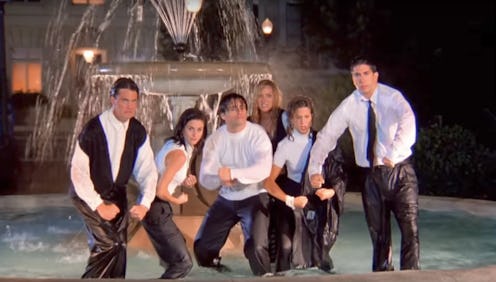Entertainment
'Friends' Creator Says The Network Tried To Change The Show

Considering its huge success, it's hard to imagine anyone had a problem with some of the original concepts for NBC's Friends. But apparently, some Hollywood execs weren't entirely on board. Friends creator David Crane and his partner Jeffrey Klarik took inspiration from their network push-back experience to create the Showtime comedy Episodes. The satirical series gives fans a behind-the-scenes view of Hollywood's inner workings. The show, in which Matt LeBlanc scored the 2012 Golden Globe for Best Actor in a Comedy TV Series for playing, well, himself, is sadly coming to a close. Before Season 5 makes its debut at the Tribeca Film Festival on April 30 (and on Showtime August 20), I speak with Crane and Klarik, and take them back to where it all began.
In Season 5, LeBlanc finds himself attempting to salvage his career by hosting a cheesy game show. This comes seasons (and many ups and downs) after it all started when he became part of a TV show against the will of its creators. In Season 1, a couple's successful British-American sitcom Lyman's Boys is brought to America, only for the Hollywood powers that be to twist it, change the show characters and focus, and even switching the name to Pucks!. It ultimately fails, leading LeBlanc to where his character is now. Obviously, the outcome of Friends was quite the opposite, still, the two processes have significant parallels, according to Crane and Klarik.
"What’s interesting about Friends, I remember, [is] when the network was still a little nervous about it," Klarik says about the show before it aired. Nervous about Friends? For real? "They were very nervous at that point doing the show where everyone’s the same, young demographic and [there's] six of them," he says. To do something about it, the network pushed for an "adult figure." "Somebody who would maybe run Central Perk, a cop on the beat they would talk to. They wanted some kind of adult supervision," he says.
So, according to Crane, they tried it. "They pushed for it, and one week we even tried introducing it in an early draft we had this cop who came in and had opinions and it was just terrible. I don’t even think it made it to the table read," he says with a laugh. "But we really pushed back on that."
And get a load of this: Crane says the show "didn't test very well" in the beginning. "There were a lot of nerves. It really wasn’t until we got on the air and we started getting decent numbers that everybody backed off." Seeing the Episodes inspiration yet?
Unfortunately, some higher ups in Hollywood feel the need to fix projects, even if they aren't broken. "It just shows you that even with Friends, the network feels the need to put their two cents in and try to mess with stuff. Immediately, they just run for the hills," Crane says. "The first time they get nervous it’s like, what do we do? How do we change this?" The creators enjoy bringing this side of the industry to the light with Episodes. "No one really knows, and these are bright people, that’s the thing. They’re nice people, but everybody’s panicked," Crane explains. To them, these processes are pretty apparent on screen. "Even today, you’ll see as they try to scramble to change a show, it’s a frightening process especially when you’re in the middle of it," Klarik says.
Sticking to their guns obviously worked with Friends, but who knows if the same were to happen in Episodes? "If everybody listened, I don’t know what would’ve changed," Crane says.
As iconic as Friends became, both men still question some of the choices made, which seems inevitable for any creator. "Jeffery and I will be traveling and we’ll be flipping the channels and Friends will come on and we’ll just look at each other and go, ‘Wow. You couldn’t of stayed 10 more minutes and come up with a better joke? That’s the joke?,’" he says. "I don’t think that ever changes."
Yet I, a religious Friends fan, beg to differ. Those jokes were priceless.